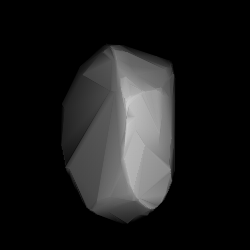2111 Tselina (prov. designation: 1969 LG) is a stony Eos asteroid from the outer regions of the asteroid belt. It was discovered on 13 June 1969, by Soviet astronomer Tamara Smirnova at Crimean Astrophysical Observatory in Nauchnij, on the Crimean peninsula. The S-type asteroid has a rotation period of 6.6 hours and measures approximately 23 kilometers (14 miles) in diameter. It was later named after the Soviet Virgin Lands Campaign.
Orbit and classification
Tselina is a member of the Eos family (606), the largest asteroid family in the outer main belt consisting of nearly 10,000 asteroids. It orbits the Sun at a distance of 2.7–3.3 AU once every 5 years and 3 months (1,914 days). Its orbit has an eccentricity of 0.10 and an inclination of 11° with respect to the ecliptic. In 1929, Tselina was first observed as 1928 RS and 1928 SO by the German and Belgian observatories at Hamburg and Uccle, respectively. The body's observation arc begins at the discovering observatory in 1968, or one year prior to its official discovery.
Naming
This minor planet was named after the tselina lands to commemorate the 25th anniversary of the Soviet Virgin Lands Campaign. The campaign was launched by Nikita Khrushchev in 1953, with the intention to significantly increase the agricultural production in the USSR. The word "tselina" (or tseliny) means "virgin soil". The official naming citation was published by the Minor Planet Center on 1 April 1980 (M.P.C. 5283).
Physical characteristics
In the Tholen classification, Tselina is a common, stony S-type asteroid.
Rotation period
In September 2001, a rotational lightcurve of Tselina was obtained from photometric observations by French amateur astronomer Laurent Bernasconi. Lightcurve analysis gave a well-defined rotation period of 6.563±0.001 hours with a brightness variation of 0.17 magnitude (U=3). In September 2012, observations by astronomers at the Palomar Transient Factory, California, gave a concurring period of 6.562±0.0021 hours with an amplitude of 0.29 magnitude (U=2).
Diameter and albedo
According to the surveys carried out by the Infrared Astronomical Satellite IRAS, the Japanese Akari satellite, and NASA's Wide-field Infrared Survey Explorer with its subsequent NEOWISE mission, Tselina measures between 22.773 and 33.02 kilometers in diameter and its surface has an albedo between 0.13 and 0.226. The Collaborative Asteroid Lightcurve Link agrees with the results obtained by IRAS, that is, an albedo of 0.1938 and a diameter of 24.54 kilometers with an absolute magnitude of 10.45.
References
- ^ "JPL Small-Body Database Browser: 2111 Tselina (1969 LG)" (2016-10-14 last obs.). Jet Propulsion Laboratory. Retrieved 3 July 2017.
- ^ Schmadel, Lutz D. (2007). "(2111) Tselina". Dictionary of Minor Planet Names. Springer Berlin Heidelberg. p. 171. doi:10.1007/978-3-540-29925-7_2112. ISBN 978-3-540-00238-3.
- ^ "LCDB Data for (2111) Tselina". Asteroid Lightcurve Database (LCDB). Retrieved 28 April 2017.
- ^ "Asteroid 2111 Tselina – Nesvorny HCM Asteroid Families V3.0". Small Bodies Data Ferret. Retrieved 26 October 2019.
- ^ Masiero, Joseph R.; Grav, T.; Mainzer, A. K.; Nugent, C. R.; Bauer, J. M.; Stevenson, R.; et al. (August 2014). "Main-belt Asteroids with WISE/NEOWISE: Near-infrared Albedos". The Astrophysical Journal. 791 (2): 11. arXiv:1406.6645. Bibcode:2014ApJ...791..121M. doi:10.1088/0004-637X/791/2/121. Retrieved 29 April 2017.
- ^ Mainzer, A.; Grav, T.; Masiero, J.; Hand, E.; Bauer, J.; Tholen, D.; et al. (November 2011). "NEOWISE Studies of Spectrophotometrically Classified Asteroids: Preliminary Results". The Astrophysical Journal. 741 (2): 25. arXiv:1109.6407. Bibcode:2011ApJ...741...90M. doi:10.1088/0004-637X/741/2/90.
- ^ Tedesco, E. F.; Noah, P. V.; Noah, M.; Price, S. D. (October 2004). "IRAS Minor Planet Survey V6.0". NASA Planetary Data System. 12: IRAS-A-FPA-3-RDR-IMPS-V6.0. Bibcode:2004PDSS...12.....T. Retrieved 22 October 2019.
- ^ Usui, Fumihiko; Kuroda, Daisuke; Müller, Thomas G.; Hasegawa, Sunao; Ishiguro, Masateru; Ootsubo, Takafumi; et al. (October 2011). "Asteroid Catalog Using Akari: AKARI/IRC Mid-Infrared Asteroid Survey". Publications of the Astronomical Society of Japan. 63 (5): 1117–1138. Bibcode:2011PASJ...63.1117U. doi:10.1093/pasj/63.5.1117. (online, AcuA catalog p. 153)
- ^ Behrend, Raoul. "Asteroids and comets rotation curves – (2111) Tselina". Geneva Observatory. Retrieved 28 April 2017.
- ^ Masiero, Joseph R.; Mainzer, A. K.; Grav, T.; Bauer, J. M.; Cutri, R. M.; Dailey, J.; et al. (November 2011). "Main Belt Asteroids with WISE/NEOWISE. I. Preliminary Albedos and Diameters". The Astrophysical Journal. 741 (2): 20. arXiv:1109.4096. Bibcode:2011ApJ...741...68M. doi:10.1088/0004-637X/741/2/68. Retrieved 28 April 2017.
- ^ Waszczak, Adam; Chang, Chan-Kao; Ofek, Eran O.; Laher, Russ; Masci, Frank; Levitan, David; et al. (September 2015). "Asteroid Light Curves from the Palomar Transient Factory Survey: Rotation Periods and Phase Functions from Sparse Photometry". The Astronomical Journal. 150 (3): 35. arXiv:1504.04041. Bibcode:2015AJ....150...75W. doi:10.1088/0004-6256/150/3/75. Retrieved 28 April 2017.
- ^ "2111 Tselina (1969 LG)". Minor Planet Center. Retrieved 28 April 2017.
- Nesvorný, D.; Broz, M.; Carruba, V. (December 2014). "Identification and Dynamical Properties of Asteroid Families". Asteroids IV. pp. 297–321. arXiv:1502.01628. Bibcode:2015aste.book..297N. doi:10.2458/azu_uapress_9780816532131-ch016. ISBN 978-0-8165-3213-1.
- "MPC/MPO/MPS Archive". Minor Planet Center. Retrieved 28 April 2017.
| Minor planets navigator | |
|---|---|
| Small Solar System bodies | |||||||
|---|---|---|---|---|---|---|---|
| Minor planets |
| ||||||
| Comets | |||||||
| Other | |||||||
